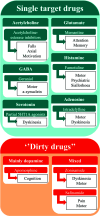Future Directions for Developing Non-dopaminergic Strategies for the Treatment of Parkinson's Disease
- PMID: 37526188
- PMCID: PMC11284721
- DOI: 10.2174/1570159X21666230731110709
Future Directions for Developing Non-dopaminergic Strategies for the Treatment of Parkinson's Disease
Abstract
The symptomatic treatment of Parkinson's disease (PD) has been dominated by the use of dopaminergic medication, but significant unmet need remains, much of which is related to non-motor symptoms and the involvement of non-dopaminergic transmitter systems. As such, little has changed in the past decades that has led to milestone advances in therapy and significantly improved treatment paradigms and patient outcomes, particularly in relation to symptoms unresponsive to levodopa. This review has looked at how pharmacological approaches to treatment are likely to develop in the near and distant future and will focus on two areas: 1) novel non-dopaminergic pharmacological strategies to control motor symptoms; and 2) novel non-dopaminergic approaches for the treatment of non-motor symptoms. The overall objective of this review is to use a 'crystal ball' approach to the future of drug discovery in PD and move away from the more traditional dopamine-based treatments. Here, we discuss promising non-dopaminergic and 'dirty drugs' that have the potential to become new key players in the field of Parkinson's disease treatment.
Keywords: GABA.; Parkinson’s disease; acetylcholine; drug targets; non-dopaminergic; pharmacology; serotonin.
Copyright© Bentham Science Publishers; For any queries, please email at epub@benthamscience.net.
Conflict of interest statement
The authors declare no conflict of interest, financial or otherwise.
Figures
Similar articles
-
Non-dopaminergic treatments for motor control in Parkinson's disease.Drugs. 2013 Sep;73(13):1405-15. doi: 10.1007/s40265-013-0105-4. Drugs. 2013. PMID: 23917951 Review.
-
Treatment of Parkinson's disease: what's in the non-dopaminergic pipeline?Neurotherapeutics. 2014 Jan;11(1):34-46. doi: 10.1007/s13311-013-0239-9. Neurotherapeutics. 2014. PMID: 24310604 Free PMC article. Review.
-
Is there room for new non-dopaminergic treatments in Parkinson's disease?J Neural Transm (Vienna). 2013 Feb;120(2):349-52. doi: 10.1007/s00702-012-0947-z. Epub 2012 Dec 11. J Neural Transm (Vienna). 2013. PMID: 23229903
-
Advances in the pharmacological treatment of Parkinson's disease: targeting neurotransmitter systems.Trends Neurosci. 2013 Sep;36(9):543-54. doi: 10.1016/j.tins.2013.06.003. Epub 2013 Jul 19. Trends Neurosci. 2013. PMID: 23876424 Review.
-
Current and investigational non-dopaminergic agents for management of motor symptoms (including motor complications) in Parkinson's disease.Expert Opin Pharmacother. 2017 Oct;18(14):1457-1465. doi: 10.1080/14656566.2017.1373089. Epub 2017 Sep 8. Expert Opin Pharmacother. 2017. PMID: 28847181 Review.
References
-
- Schwab R.S., England A.C., Jr, Amantadine H.C.L. Amantadine HCL (Symmetrel) and its relation to Levo-Dopa in the treatment of Parkinson’s disease. Trans. Am. Neurol. Assoc. 1969;94:85–90. - PubMed
-
- Birchfield R.I. Levodopa: Problems, promise, patience and persistence. Northwest Med. 1970;69(8):561–563. - PubMed
Publication types
MeSH terms
Substances
LinkOut - more resources
Full Text Sources
Medical
Research Materials
Miscellaneous


